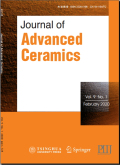- 钛学术文献服务平台 \
- 学术期刊 \
- 工业技术期刊 \
- 化学工业期刊 \
- 先进陶瓷(英文版)期刊 \
Achieving ultra-broadband electromagnetic wave absorption in high-entropy transition metal carbides(HE TMCs)
Achieving ultra-broadband electromagnetic wave absorption in high-entropy transition metal carbides(HE TMCs)
基本信息来源于合作网站,原文需代理用户跳转至来源网站获取
摘要:
Electronic devices pervade everyday life,which has triggered severe electromagnetic(EM)wave pollution.To face this challenge,developing EM wave absorbers with ultra-broadband absorption capacity is critically required.Currently,nano-composite construction has been widely utilized to realize impedance match and broadband absorption.However,complex experimental procedures,limited thermal stability,and interior oxidation resistance are still unneglectable issues.Therefore,it is appealing to realize ultra-broadband EM wave absorption in single-phase materials with good stability.Aiming at this target,two high-entropy transition metal carbides(HE TMCs)including(Zr,Hf,Nb,Ta)C(HE TMC-2)and(Cr,Zr,Hf,Nb,Ta)C(HE TMC-3)are designed and synthesized,of which the microwave absorption performance is investigated in comparison with previously reported(Ti,Zr,Hf,Nb,Ta)C(HE TMC-1).Due to the synergistic effects of dielectric and magnetic losses,HE TMC-2 and HE TMC-3 exhibit better impedance match and wider effective absorption bandwidth(EAB).In specific,the exclusion of Ti element in HE TMC-2 endows it optimal minimum reflection loss(RLmin)and EAB of-41.7 dB(2.11 mm,10.52 GHz)and 3.5 GHz(at 3.0 mm),respectively.Remarkably,the incorporation of Cr element in HE TMC-3 significantly improves the impedance match,thus realizing EAB of 10.5,9.2,and 13.9 GHz at 2,3,and 4 mm,respectively.The significance of this study lays on realizing ultra-broadband capacity in HE TMC-3(Cr,Zr,Hf,Nb,Ta),demonstrating the effectiveness of high-entropy component design in tailoring the impedance match.

推荐文章
Effects of organic mineral fertiliser on heavy metal migration and potential carbon sink in soils in
Karst
Soil pollution
Cd
Organic mineral fertilisers
Carbon sink
The oceanic cycles of the transition metals and their isotopes
Ocean biogeochemistry
Metal micronutrients
Stable isotopes
Thermodynamic properties of San Carlos olivine at high temperature and high pressure
San Carlos olivine
Thermodynamic property
Thermal expansion
Heat capacity
Temperature gradient
内容分析
关键词云
关键词热度
相关文献总数
(/次)
(/年)
引文网络
引文网络
二级参考文献 (0)
共引文献 (0)
参考文献 (0)
节点文献
引证文献 (0)
同被引文献 (0)
二级引证文献 (0)
2022(0)
- 参考文献(0)
- 二级参考文献(0)
- 引证文献(0)
- 二级引证文献(0)
引文网络交叉学科
相关学者/机构
期刊影响力
先进陶瓷(英文版)
主办单位:
清华大学
出版周期:
季刊
ISSN:
2226-4108
CN:
10-1154/TQ
开本:
出版地:
邮发代号:
创刊时间:
语种:
eng
出版文献量(篇)
290
总下载数(次)
0
总被引数(次)
157
期刊文献
相关文献
推荐文献

 免费查重
免费查重










